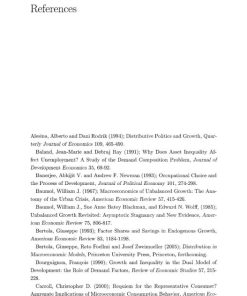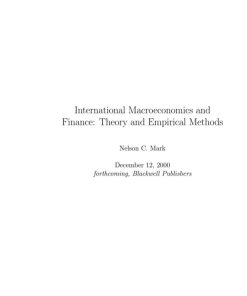Advanced macroeconomics 5th Edition by David Romer ISBN 9781260231250 1260231259
$50.00 Original price was: $50.00.$25.00Current price is: $25.00.
Authors:Advanced macroeconomics-McGraw-Hill Companies (1996) , Author sort:Companies, Advanced macroeconomics-McGraw-Hill
Advanced macroeconomics 5th Edition by David Romer – Ebook PDF Instant Download/Delivery. 9781260231250 ,1260231259
Full download Advanced macroeconomics 5th Edition after payment
Product details:
ISBN 10: 1260231259
ISBN 13: 9781260231250
Author: David Romer
The fifth edition of Romer’s Advanced Macroeconomics continues its tradition as the standard text and the starting point for graduate macroeconomics courses and helps lay the groundwork for students to begin doing research in macroeconomics and monetary economics. Romer presents the major theories concerning the central questions of macroeconomics. The theoretical analysis is supplemented by examples of relevant empirical work, illustrating the ways that theories can be applied and tested. In areas ranging from economic growth and short-run fluctuations to the natural rate of unemployment and monetary policy, formal models are used to present and analyze key ideas and issues.
The book has been extensively revised to incorporate important new topics and new research, eliminate
Advanced macroeconomics 5th Edition Table of contents:
Chapter 1 The Solow Growth Model
1.1 Some Basic Facts about Economic Growth
1.2 Assumptions
1.3 The Dynamics of the Model
1.4 The Impact of a Change in the Saving Rate
1.5 Quantitative Implications
1.6 The Solow Model and the Central Questions of Growth Theory
1.7 Empirical Applications
1.8 The Environment and Economic Growth
Problems
Chapter 2 Infinite-Horizon And Overlapping-Generations Models
Part A The Ramsey Cass Koopmans Model
2.1 Assumptions
2.2 The Behavior of Households and Firms
2.3 The Dynamics of the Economy
2.4 Welfare
2.5 The Balanced Growth Path
2.6 The Effects of a Fall in the Discount Rate
2.7 The Effects of Government Purchases
Part B THE DIAMOND MODEL
2.8 Assumptions
2.9 Household Behavior
2.10 The Dynamics of the Economy
2.11 The Possibility of Dynamic Inefficiency
2.12 Government in the Diamond Model
Problems
Chapter 3 Endogenous Growth
3.1 Framework and Assumptions
3.2 The Model without Capital
3.3 The General Case
3.4 The Nature of Knowledge and the Determinants of the Allocation of Resources to R&D
3.5 The Romer Model
3.6 Empirical Application: Time-Series Tests of Endogenous Growth Models
3.7 Empirical Application: Population Growth and Technological Change since 1 Million B.C.
3.8 Models of Knowledge Accumulation and the Central Questions of Growth Theory
Problems
Chapter 4 Cross-Country Income Differences
4.1 Extending the Solow Model to Include Human Capital
4.2 Empirical Application: Accounting for Cross-Country Income Differences
4.3 Social Infrastructure
4.4 Empirical Application: Social Infrastructure and Cross-Country Income Differences
4.5 Beyond Social Infrastructure
4.6 Differences in Growth Rates
Problems
Chapter 5 Real-Business-Cycle Theory
5.1 Introduction: An Overview of Economic Fluctuations
5.2 An Overview of Business-Cycle Research
5.3 A Baseline Real-Business-Cycle Model
5.4 Household Behavior
5.5 A Special Case of the Model
5.6 Solving the Model in the General Case
5.7 Implications
5.8 Empirical Application: Calibrating a Real-Business-Cycle Model
5.9 Empirical Application: Money and Output
5.10 Assessing the Baseline Real-Business-Cycle Model
Problems
Chapter 6 Nominal Rigidity
Part A EXOGENOUS NOMINAL RIGIDITY
6.1 A Baseline Case: Fixed Prices
6.2 Price Rigidity, Wage Rigidity, and Departures from Perfect Competition in the Goods and Labor Markets
6.3 Empirical Application: The Cyclical Behavior of the Real Wage
6.4 Toward a Usable Model with Exogenous Nominal Rigidity
Part B Microeconomic Foundations of Incomplete Nominal Adjustment
6.5 A Model of Imperfect Competition and Price-Setting
6.6 Are Small Frictions Enough?
6.7 Real Rigidity
6.8 Coordination-Failure Models and Real Non-Walrasian Theories
6.9 The Lucas Imperfect-Information Model
Problems
Chapter 7 DYNAMIC STOCHASTIC GENERAL-EQUILIBRIUM MODELS OF FLUCTUATIONS
7.1 Building Blocks of Dynamic New Keynesian Models
7.2 Predetermined Prices: The Fischer Model
7.3 Fixed Prices: The Taylor Model
7.4 The Calvo Model and the New Keynesian Phillips Curve
7.5 State-Dependent Pricing
7.6 Empirical Applications
7.7 Models of Staggered Price Adjustment with Inflation Inertia
7.8 The Canonical New Keynesian Model
7.9 The Forward Guidance Puzzle
7.10 Other Elements of Modern New Keynesian DSGE Models of Fluctuations
Problems
Chapter 8 Consumption
8.1 Consumption under Certainty: The Permanent-Income Hypothesis
8.2 Consumption under Uncertainty: The Random-Walk Hypothesis
8.3 Empirical Application: Two Tests of the Random-Walk Hypothesis
8.4 The Interest Rate and Saving
8.5 Consumption and Risky Assets
8.6 Beyond the Permanent-Income Hypothesis
8.7 A Dynamic-Programming Analysis of Precautionary Saving
Problems
Chapter 9 Investment
9.1 Investment and the Cost of Capital
9.2 A Model of Investment with Adjustment Costs
9.3 Tobin’s q
9.4 Analyzing the Model
9.5 Implications
9.6 Empirical Application: q and Investment
9.7 The Effects of Uncertainty
9.8 Kinked and Fixed Adjustment Costs
Problems
Chapter 10 Financial Markets and Financial Crises
10.1 A Model of Perfect Financial Markets
10.2 Agency Costs and the Financial Accelerator
10.3 Empirical Application: Cash Flow and Investment
10.4 Mispricing and Excess Volatility
10.5 Empirical Application: Evidence on Excess Volatility
10.6 The Diamond Dybvig Model
10.7 Contagion and Financial Crises
10.8 Empirical Application: Microeconomic Evidence on the Macroeconomic Effects of Financial Crises
Problems
Chapter 11 Unemployment
11.1 A Generic Efficiency-Wage Model
11.2 The Shapiro-Stiglitz Model
11.3 Contracting Models
11.4 Search and Matching Models
11.5 Implications
11.6 Empirical Applications
Problems
Chapter 12 Monetary Policy
12.1 Inflation, Money Growth, and Interest Rates
12.2 Monetary Policy and the Term Structure of Interest Rates
12.3 The Microeconomic Foundations of Stabilization Policy
12.4 Optimal Monetary Policy in a Simple Backward-Looking Model
12.5 Optimal Monetary Policy in a Simple Forward-Looking Model
12.6 Some Additional Issues Concerning Interest-Rate Rules
12.7 The Zero Lower Bound on the Nominal Interest Rate
12.8 The Dynamic Inconsistency of Low-Inflation Monetary Policy
12.9 Empirical Applications
12.10 Seignorage and Inflation
Problems
Chapter 13 Budget Deficits And Fiscal Policy
13.1 The Government Budget Constraint
13.2 Ricardian Equivalence
13.3 Tax-Smoothing
13.4 Political-Economy Theories of Budget Deficits
13.5 Strategic Debt Accumulation
13.6 Delayed Stabilization
13.7 Empirical Application: Politics and Deficits in Industrialized Countries
13.8 The Costs of Deficits
13.9 A Model of Sovereign Debt Crises
People also search for Advanced macroeconomics 5th Edition:
best advanced macroeconomics textbook
romer advanced macroeconomics solutions
david romer advanced macroeconomics 5th edition solutions
advanced macroeconomics theory
You may also like…
eBook CHM
Javascript The Definitive Guide 5th Edition by David Flanagan ISBN 0596101996 9780596101992
eBook PDF
Cardiac Surgery in the Adult 5th Edition by Lawrence Cohn, David Adams ISBN 0071846026 9780071846028
eBook PDF
Manual of Forensic Odontology 5th Edition by David Williams,David Greene 9781040081389 104008138X
eBook PDF
Manual of Forensic Odontology 5th Edition by David Greene,David Williams 9781040081389 104008138X












